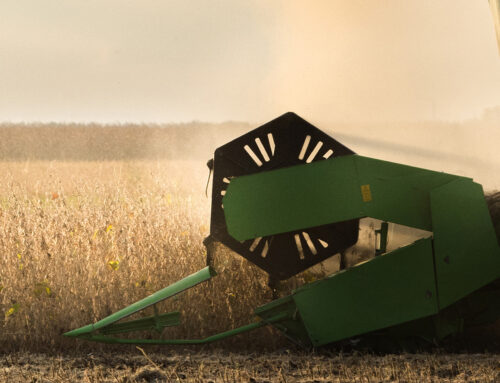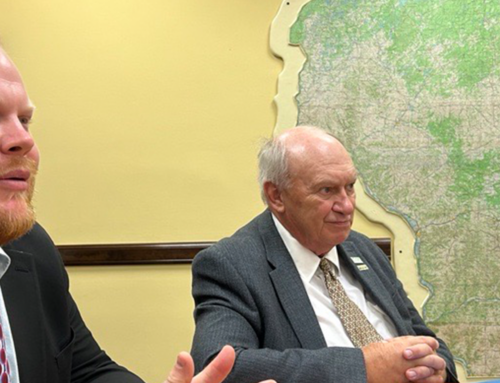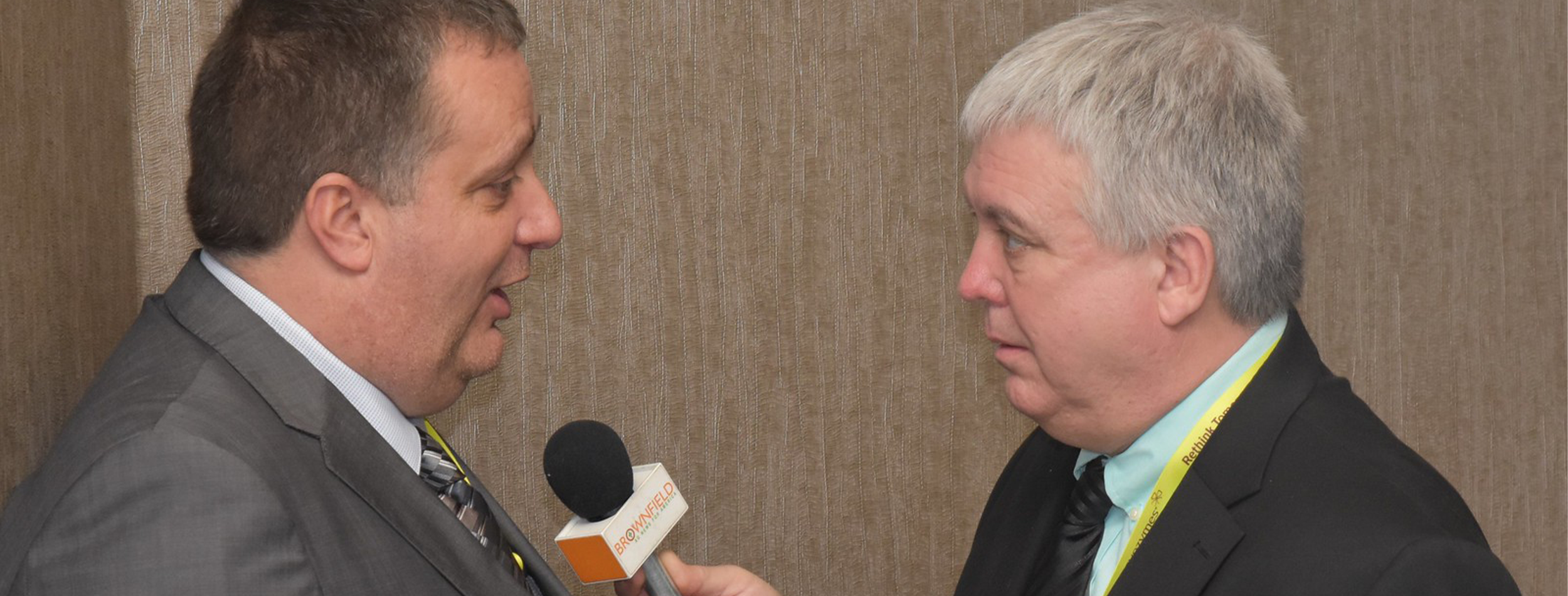
Fine fifty: Brownfield Ag News celebrates half-century on the airwaves
Share This
The original vision behind Brownfield Ag News can be traced back to academia. Over a half-century ago, while studying at the Missouri School of Journalism, Clyde Lear committed his master’s thesis toward starting an agriculture radio network.
“Clyde always had this dream,” said Cyndi Young, longtime director of Brownfield News & Ag Operations. “That dream came true.”

Clyde Lear and Derry Brownfield
But first, Lear had to put his plan into action. While toiling away in the KLIK newsroom in his native Jefferson City, Mo., Lear struck up a friendship with Farm Director Derry Brownfield. The two journalists combined their names to create Learfield Communications and launched after recruiting four angel investors and partnering with nine radio affiliates. In January 1973, Lear fulfilled his dream of broadcasting his own ag radio network when the Brownfield Network hit the airwaves, helping to give a voice to American’s heartland, which Lear felt had been neglected by national outlets. But it wasn’t exactly a glamorous start for the fledgling operation; “good, not fancy” was the company’s motto. Lear signed affiliates, hustled to sell ads, oversaw audio engineering; Derry Brownfield, meanwhile, dictated his broadcasts over a telephone line. But within the company’s first year, 35 radio stations across Missouri began broadcasting Brownfield programming before expanding into Illinois, Iowa and Arkansas.
Fifty years later, Brownfield Ag News, a division of Learfield, has grown into an agriculture media powerhouse and supports the nation’s largest team of farm broadcasters. Brownfield’s 13 ag radio journalists work with nearly 600 affiliate radio stations across 12 states and multiple media platforms to deliver timely agriculture news to listeners.
“This team is more like a large group of brothers and sisters than coworkers,” said Brownfield broadcaster Larry Lee, who covers the Wisconsin beat for the station. “We all get along very well.”
Learfield has also diversified by securing multimedia rights for more than 50 collegiate institutions. And throughout 2023, the company celebrated its milestone anniversary with listeners, state affiliates and radio partners like the Wisconsin Soybean Association – which, of course, also marked a half-century in business in 2023.
“Fifty years is a big deal,” Young said, “and it’s grown way beyond what Clyde originally envisioned. We are more than Brownfield now.”
Lear, now retired but a frequent visitor to the company’s headquarters in Jefferson City, developed an eye for honing talent both on-air and behind the scenes.
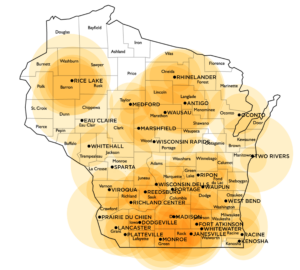
Brownfield’s coverage in Wisconsin
“Clyde believed in the people,” said Young, a former National Farm Broadcaster of the Year who’s been with the company for 25 years. “He was a big believer in finding the people who had the passion, and taking good care of the people, taking good care of our affiliate partners and taking good care of our advertisers and public relations people, as well as our listeners.”
Lear also cultivated a corporate culture that brings people together.
“For 50 years, it’s been a feeling of family,” Young said. “With Brownfield, it’s about who you are, not just what you can bring and I think that’s served us well.”
The network has adapted to shifts in how agriculture professionals consume news, while maintaining its journalistic ethics. Those values, Young said, are reasons why legislative leaders and the USDA contact Brownfield to share their messaging.
“Just as tech has changed the tools in agriculture, tech has changed our tools,” Young said. “People go to a lot of places to get information today, but what they really want with their news and information is sources that they can trust.”
On the dial
Brownfield has joined the broadcasting industry in advocating against the removal of AM radio access from electric cars. Currently, eight of the nation’s 20 car manufacturers have removed AM from electric cars. Still, over 80 million American listen to AM radio every month.
“In rural communities, we are still listening to local radio,” Young said. “It may be all Spotify in Chicago, but out here, we need that source of important information. It’s vital in rural America.”
In 2023, a bipartisan group of lawmakers introduced legislation in the Senate that would direct automakers to maintain AM radio in new vehicles. Removing AM radio would deprive listeners of a critical communication outlet in the event of an emergency, said Sen. Tammy Baldwin, co-sponsor of the AM For Every Vehicle Act.
“Wisconsinites, particularly those living in our rural and farming communities, rely on AM radio in emergencies, to provide them with their high-quality local news, and to lift up the voices of local businesses, organizations, and people,” said Senator Baldwin. “I am proud to work with my Democratic and Republican colleagues to go to bat for the Americans who want and need AM radio to do their jobs, stay safe and support their local communities.”
Face to face
As a longtime broadcaster with a deep background in local radio, Larry Lee mirrors Brownfield’s community-minded ethos.
“I have said many times the strongest stone in the structure is in the foundation,” Young said. “Our foundation is in local radio and in ag, and Larry understands the importance of local.”
Lee is a Wisconsinite through and through, down to his sporting affiliations. He was raised on a fishing resort near Chetek and counts several family members as farmers. He’s established a 40-year long career in Wisconsin radio and joined Brownfield in 2016 after serving as WSAU’s news director in Wausau.
“I joined Brownfield quite by accident,” he said. “I wasn’t looking but was recruited to apply for the position. That’s when I met Cyndi and she thought I’d be a good fit.”
Young said that Lee’s strong work ethic leads him to build relationships and engage directly with farmers. Meeting with farmers face-to-face is one of his favorite parts of the job.
“Larry is the Energizer Bunny,” Young said. “He’d be out on the road if I would let him because he likes to go to the source. He loves to learn and is an important part of the team.”
Lee does get to hit the pavement when he travels every January to the annual Wisconsin Corn-Soy Expo to connect with producers and industry leaders.
“I think the combination of corn and soy along with the pork producers make a good combination for a show,” he said. “It’s a great event and I enjoy visiting with producers.”
In Lee’s experience, some farmers are naturals on the mic while others are more reluctant to interviews. Tony Mellenthin, who represents Wisconsin on the United Soybean Board, falls into the former category.
“Tony is one of my favorites,” Lee said. ‘He’s one smart cookie and I think he has a really bright future as a leader.”
Mellenthin, who also previously served as WSA president, said working with Brownfield helps deliver Wisconsin Soybean Program’s (WSP) messages to producers, legislators and current and future members.
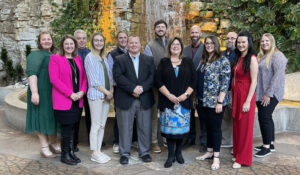
Brownfield’s team at the 2022 National Association of Farm Broadcasting Convention
“Radio partners like Brownfield are vitally important to commodity organizations like ours to keep our members informed of our policy activities, along with our checkoff successes,” Mellenthin said. “Working with Brownfield is great because you can tell that they’re not just doing it to run a story but because they’re genuinely interested in your crop and your industry. They care.”
The partnership between WSP and Brownfield is one that continues growing through events, interviews and sponsorship opportunities.
“Since Wisconsin Soybean has started to reorganize and increase its presence in Wisconsin ag media, it’s not just me calling them,” Lee said. “I’m hearing from them now, and it’s nice to have a two-way relationship.”
The Brownfield team, scattered across the nation’s heartland down into the southern Delta, is built for today’s digital communications world. Lee, who started his career by working with reel-to-reel tape, has adapted to the technological advances in both farming and broadcasting, which suits him just fine.
There’s never a dull moment in agriculture,” he said. “Things are always changing. Tech is changing and evolving constantly. You have to keep up.”
By staying nimble and knowing its audience, Learfield and Brownfield are built to last.
“It’s been hard work, but very rewarding,” Young said. “Local radio isn’t going anywhere.”

